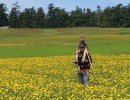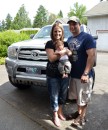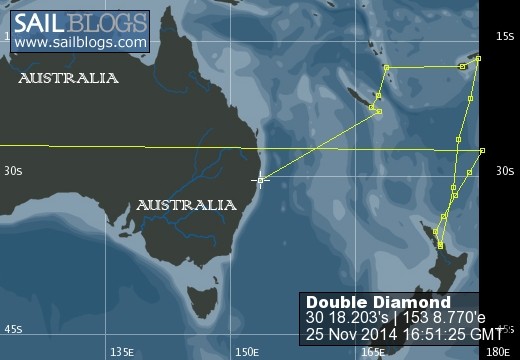
Sailing Double Diamond
25 November 2014 | Coffs Harbor
18 November 2014 | Coffs Harbor, Australia
02 November 2014 | Ill des Pins
01 November 2014
17 October 2014
14 October 2014 | Port Vila
06 October 2014 | Saweni Bay
01 September 2014 | Kirkland, Washington
04 June 2014 | Savusavu, Fiji
22 May 2014 | 21 10'S:178 19'E,
20 May 2014 | 25 46'S:176 52'E,
19 May 2014 | 30 57'S:176 16'E,
15 May 2014 | Auckland, New Zealand
17 April 2014 | Kirkland
12 April 2014 | Kirkland
04 April 2014 | Gulf Harbour Marina, New Zealand
27 March 2014 | Auckland, New Zealand
13 March 2014 | Auckland, New Zealand
22 December 2013
02 November 2013 | Opua, New Zealand
Welcome to Straya Mate!
25 November 2014 | Coffs Harbor
Jeff / Melody Photos
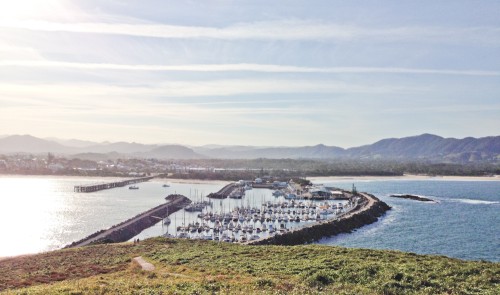
We arrived in Australia at what is called the "mid-coast" and made our landfall at Coffs Harbor, a small fishing and recreational harbor on the central coast of Australia. Coffs Harbor is about 200 miles north of Sydney, which is our ultimate destination for the next couple of months.
Maybe you already knew this, but let me say it anyway: Australia is a big place. As Bill Bryson puts it in his book "A Sunburned Country", it's not only big, it's also the biggest place on earth that almost nobody from anywhere else knows much of anything about. He contends it's just too far away from the rest of the world to be on anyone's radar. We certainly admit to not knowing much about Australia - and still barely do. It seems there is a lot to "discover" here.
Relative to its size, think about it this way (and since we're "down-under", stand on your head and prepare to think about it upside down). The very top of Australia (roughly the Great Barrier Reef) is about the same latitude as Guatemala and the very bottom of Australia (Tasmania) is about the same latitude as the Oregon/California border. That's a whole lotta coastline - and that's just the east coast.
Where we have made landfall is about the southern hemisphere equivalent of Ensenada, Mexico. Where we plan to leave the boat for the holidays in Sydney, about 200 miles south of here, is roughly San Diego. Yes, Ensenada is south of San Diego and Sydney is south of Coffs Harbor, but remember: we're now in upside-down-world. Climate-wise, going south here is like going north back home.
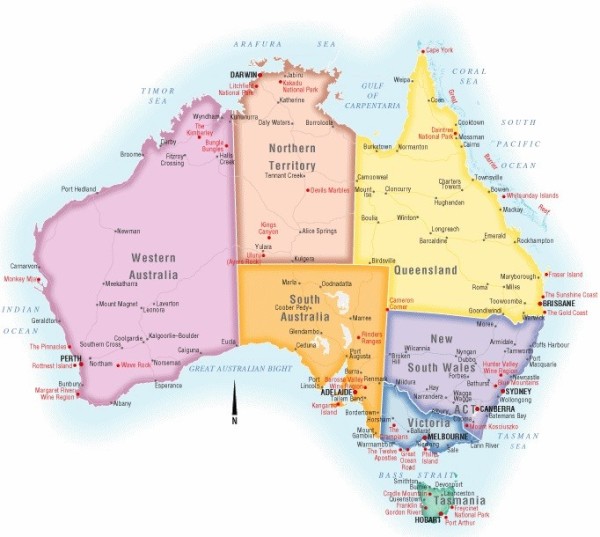
Coffs Harbor has a reputation among fellow cruisers for being an efficient and friendly harbor to accomplish the customs check-in process. True to its reputation, everything went quite smoothly for us as well - except for the cost.
Bear with me on that last detail.
Upon departure from New Caledonia and for several days before arriving, we were fairly certain our arrival in Australia would be early on Friday, which would be perfect for checking in and avoiding any extra charges for a weekend arrival.
Can see where this is going?
And it was all going as planned... until we ran into a serious one to two knot on-the-nose current on Wednesday and Thursday, slowing our forward progress tremendously. The difference between sailing at 8 or 9 knots and sailing at 5 or 6 knots is a big deal in terms of how much ocean a boat can cover in 24 hours. The capper was running into an electrical storm around 'O Dark Thirty - about two hours before sunrise - on Friday morning, which we talked about in our previous post.
All the dodging we did to avoid getting struck by lightning cost us several hours of forward progress (we actually turned around and sailed the other way at one point) in addition to the general slowdown from the head-on current we had to wrestle with. Instead of arriving on Friday AM, we arrived late Friday afternoon, just as Customs was closing for the weekend. Yuck.
The result? True to what we were told by others, this was a great place to check-in. Regardless of the whole weekend thing, Customs officials were ready for us bright and early on Saturday AM and the check-in went quick and smooth. But because it was Saturday, the cost of processing us went from $330 to $668. Yikes!
Don't misunderstand: none of the costs, additional or otherwise went to pay the two guys that inspected us and completed all the paperwork. That was all free, weekend or not. The costs were all about the disposal of our "biosecurity items".
Essentially this involved removing our remaining fresh fruits, vegetables and frozen meat from our refrigerators and freezer and dumping it all into heavy-duty orange plastic bags and sealing them up tight with orange tape. We only wish we would have had the presence of mind to take a photo or two of this. The plastic bags alone - even empty - were impressive.
This is all done to protect Australian agriculture from invasive pests and apparently everything that is removed is incinerated within 24 hours. Except on weekends. On weekends they freeze it all in a building at the end of the dock and then transport it to the incinerator on Monday, hence the additional cost - or so we were told.
We knew the food disposal routine was coming and tried to insure that we would arrive without too much food left over from the crossing, a task at which we were fairly successful. (Uurp.) We get what biosecurity is all about and it makes sense to us. We also hate to throw food away.
According to the inspectors, if we had arrived in a wood boat instead of our fiberglass boat, things could have really gotten out of control. They seemed rather delighted to have a recent vintage boat like ours to inspect. One officer pointed out two older wooden ketches docked across the pier from us, holding them out as an example of what they dread.
If we were one of those boats he might have been onboard for hours, maybe the entire day - or two. They would have torn the boat open in the inspection process and if wood-borne pests were found, the entire boat would have been quarantined until it could be fumigated and certified pest-free, all at the owner's expense. Apparently that can cost into the thousands of dollars. Think about it: the cost of our two half-full bags of biosecurity stuff was well on the way to a grand. Imagine a whole boat bagged up - which is what they actually do.
One other note about coming to Australia via boat: They require lots of advance notice concerning your intended arrival date and your intended arrival port. The fines for not providing the required notice are in the thousands and immediate jailing upon arrival is a possibility. They require at minimum 96 hours of advance notice of your intention to arrive AND they require that you have applied for and possess an approved visa for everyone on board before sending that notice. To their credit, they provide an online visa application tool that generated e-visas for us and were sent to us via email within an hour.
Except for the visa prior-approval requirement, sailing to New Zealand is not much different from sailing to Australia in regards to advance notice requirements. But still... Compare this to entering Canada via boat, where you land at a dock, walk up to the customs courtesy telephone and call. "Hi. We're here. Yes sir, we'll leave our potatoes in the box." And that's about all there is to it. Not so in Australia.
Upon arrival, we were carrying no Australian currency, assuming we would be able to go to an ATM at some point and get cash for any customs fees. We began to fear that the amount of cash they were going to require might first involve some online transfers or a visit to a money exchange, all of which would be a bit time consuming. No need. The customs officials had a wireless credit card terminal with them for collecting the fees right there on the spot and took Visa or MasterCard.
"Welcome to Australia. Need a receipt for that?
Maybe you already knew this, but let me say it anyway: Australia is a big place. As Bill Bryson puts it in his book "A Sunburned Country", it's not only big, it's also the biggest place on earth that almost nobody from anywhere else knows much of anything about. He contends it's just too far away from the rest of the world to be on anyone's radar. We certainly admit to not knowing much about Australia - and still barely do. It seems there is a lot to "discover" here.
Relative to its size, think about it this way (and since we're "down-under", stand on your head and prepare to think about it upside down). The very top of Australia (roughly the Great Barrier Reef) is about the same latitude as Guatemala and the very bottom of Australia (Tasmania) is about the same latitude as the Oregon/California border. That's a whole lotta coastline - and that's just the east coast.
Where we have made landfall is about the southern hemisphere equivalent of Ensenada, Mexico. Where we plan to leave the boat for the holidays in Sydney, about 200 miles south of here, is roughly San Diego. Yes, Ensenada is south of San Diego and Sydney is south of Coffs Harbor, but remember: we're now in upside-down-world. Climate-wise, going south here is like going north back home.

Coffs Harbor has a reputation among fellow cruisers for being an efficient and friendly harbor to accomplish the customs check-in process. True to its reputation, everything went quite smoothly for us as well - except for the cost.
Bear with me on that last detail.
Upon departure from New Caledonia and for several days before arriving, we were fairly certain our arrival in Australia would be early on Friday, which would be perfect for checking in and avoiding any extra charges for a weekend arrival.
Can see where this is going?
And it was all going as planned... until we ran into a serious one to two knot on-the-nose current on Wednesday and Thursday, slowing our forward progress tremendously. The difference between sailing at 8 or 9 knots and sailing at 5 or 6 knots is a big deal in terms of how much ocean a boat can cover in 24 hours. The capper was running into an electrical storm around 'O Dark Thirty - about two hours before sunrise - on Friday morning, which we talked about in our previous post.
All the dodging we did to avoid getting struck by lightning cost us several hours of forward progress (we actually turned around and sailed the other way at one point) in addition to the general slowdown from the head-on current we had to wrestle with. Instead of arriving on Friday AM, we arrived late Friday afternoon, just as Customs was closing for the weekend. Yuck.
The result? True to what we were told by others, this was a great place to check-in. Regardless of the whole weekend thing, Customs officials were ready for us bright and early on Saturday AM and the check-in went quick and smooth. But because it was Saturday, the cost of processing us went from $330 to $668. Yikes!
Don't misunderstand: none of the costs, additional or otherwise went to pay the two guys that inspected us and completed all the paperwork. That was all free, weekend or not. The costs were all about the disposal of our "biosecurity items".
Essentially this involved removing our remaining fresh fruits, vegetables and frozen meat from our refrigerators and freezer and dumping it all into heavy-duty orange plastic bags and sealing them up tight with orange tape. We only wish we would have had the presence of mind to take a photo or two of this. The plastic bags alone - even empty - were impressive.
This is all done to protect Australian agriculture from invasive pests and apparently everything that is removed is incinerated within 24 hours. Except on weekends. On weekends they freeze it all in a building at the end of the dock and then transport it to the incinerator on Monday, hence the additional cost - or so we were told.
We knew the food disposal routine was coming and tried to insure that we would arrive without too much food left over from the crossing, a task at which we were fairly successful. (Uurp.) We get what biosecurity is all about and it makes sense to us. We also hate to throw food away.
According to the inspectors, if we had arrived in a wood boat instead of our fiberglass boat, things could have really gotten out of control. They seemed rather delighted to have a recent vintage boat like ours to inspect. One officer pointed out two older wooden ketches docked across the pier from us, holding them out as an example of what they dread.
If we were one of those boats he might have been onboard for hours, maybe the entire day - or two. They would have torn the boat open in the inspection process and if wood-borne pests were found, the entire boat would have been quarantined until it could be fumigated and certified pest-free, all at the owner's expense. Apparently that can cost into the thousands of dollars. Think about it: the cost of our two half-full bags of biosecurity stuff was well on the way to a grand. Imagine a whole boat bagged up - which is what they actually do.
One other note about coming to Australia via boat: They require lots of advance notice concerning your intended arrival date and your intended arrival port. The fines for not providing the required notice are in the thousands and immediate jailing upon arrival is a possibility. They require at minimum 96 hours of advance notice of your intention to arrive AND they require that you have applied for and possess an approved visa for everyone on board before sending that notice. To their credit, they provide an online visa application tool that generated e-visas for us and were sent to us via email within an hour.
Except for the visa prior-approval requirement, sailing to New Zealand is not much different from sailing to Australia in regards to advance notice requirements. But still... Compare this to entering Canada via boat, where you land at a dock, walk up to the customs courtesy telephone and call. "Hi. We're here. Yes sir, we'll leave our potatoes in the box." And that's about all there is to it. Not so in Australia.
Upon arrival, we were carrying no Australian currency, assuming we would be able to go to an ATM at some point and get cash for any customs fees. We began to fear that the amount of cash they were going to require might first involve some online transfers or a visit to a money exchange, all of which would be a bit time consuming. No need. The customs officials had a wireless credit card terminal with them for collecting the fees right there on the spot and took Visa or MasterCard.
"Welcome to Australia. Need a receipt for that?
Weather Window
18 November 2014 | Coffs Harbor, Australia
Jeff/Photos by Melody
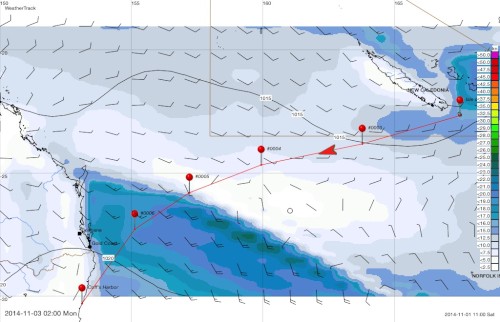
We are often asked "Isn't sailing across the ocean scary?"
98% of the time... No. The actual sailing - being on the ocean for several days and nights in a row - is often more tedious than anything and hard to describe as scary.
The most scary part of a making a crossing for us, (if "scary" is the right word - perhaps "the most anxious part" is a better descriptor) comes before departure, before actually being out on the ocean. Other sailors may feel differently, but our anxiousness revolves around trying to predict the weather on the upcoming passage and choosing the right time to leave. In Sailor-ease, this is called choosing a good "weather window".
Choosing a good weather window is a funny thing. On the not-so-funny end of things is the obvious "bad" weather window - leaving during a storm or (maybe worse) sailing into a storm. On the other end of the scale are flat calm seas, which might sound pleasant, but this end of the scale is often accompanied by no wind. Remember, we're a sailboat. Wind propels us. Yes, we do have engines, but they're really not much fun to use. They make noise, the exhaust smells, the fuel they use is costly and using them for an extended period of time can become quite boring. Sailing is much more fun and mentally challenging. To sail, we need wind.
So wind is good. Too much wind is bad and too little wind is bad in it's own rather annoying way. Fretting over choosing a good weather window has something of a Goldilocks process to it - oh that's too much, oh that's too little, oh that's just right.
On top of all that, figuring out the weather is its own peculiar kind of puzzle made more difficult by the fact that it's all about predicting what will happen out there. It's one thing to look out the window and say "oh, the wind is blowing outside". It's a bit more complicated to say "Oh, the wind WILL be blowing five days from now - 700 miles from here - and at this direction and at this speed". We're not just trying to see what the weather is like right now, we have to predict it, for several days out and a long way away.
So we fret. We sit at our computer and look at weather charts. We pick up our iPad and run various weather apps to see how they are modeling the coming weather. Perhaps we pick up the phone and pay a professional weather router to give us their forecasts and departure advice. We talk with other sailors and ask them what they think about the weather, when do they plan to depart - and why.
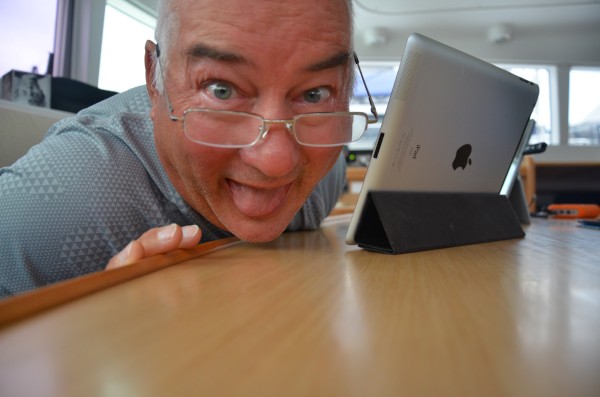
Choosing when to leave New Caledonia this time was complicated. Complicated enough that we know several boats who have not even left yet (or left for a day but went back) because the weather systems coming up out of the southern ocean have been difficult to predict these past few weeks, with quick changes occurring daily or with solid predictions of poor sailing conditions on the route they wish to sail keeping them at the dock. Boats sailing to New Zealand from New Caledonia have had a particularly difficult time.
We left with two sailing plans and the idea that we would divert to one or the other if weather changed mid-passage from what was predicted upon departure. Sailing to Australia from New Caledonia affords the luxury of multiple routes given that there is a thousand plus miles of Australian coastline at which to aim. Sailing to New Zealand does not have many options. Sailing there means pretty much going to one spot - Opua or perhaps Whangerie or Auckland, but the difference between those choices is at best 150 miles.
One other thing about bad sailing weather is that it's not so bad if you choose to sail into it. And by bad weather, I don't mean 50 knot winds and 6 meter seas. Nobody chooses to sail into that willingly - at least no one we know. Bad weather for us (or perhaps I should say uncomfortable weather that we try to avoid) is 35 to 40 knots and 4 meter seas. Our sweet spot is 15 knots and 1 meter seas, but we can easily sail in 20 to 25 knots and 2 to 3 meter seas - conditions that are quite common in the South Pacific.
Our forecasts said that on day 3 out of New Caledonia, we would see 25 to 30 knot winds and 3+ meter seas for about 24 hours. That's getting close to the high end of our comfort range, but... it's one thing to choose to sail into those conditions and another to have those conditions take you by surprise. Trying to figure out what kind of surprises might be lurking out there is a major cause of pre-departure fretting. See picture above. Again.
Sure enough, the weather front that was predicted for day 3 showed up as forecast during our passage, but no worries mate, we were ready for it and being ready for it makes all the difference in the world. In fact, when the weather front showed up, it was kind of comforting to know that the models were right and dealing us no surprises. Prior to its arrival, we enjoyed 30 hours of downwind spinnaker sailing in 15 to 20 knots of sunshine, following seas and a bright full moon at night. We could not complain.
Our experience with this front is also something of a tribute to modern sailing. Unlike sailing days of old, we are able to download updated weather forecasts while underway every day via radio or satphone - every 6 hours if we want to. Our weather updates during the passage told us that the predicted front was losing its punch. Given that information we moved to plan 2 - sailing directly to the central Australian coast rather than sailing high (aiming for the north coast) and keeping away from the front coming up from the south for as long as possible. As a result, we plunged directly into the front and worked our way through it in about 12 hours, finding that indeed, it was much weakened from what we anticipated upon departure.
We did get one surprise: Lightning. On day 6, a little over 100 miles away from the coast (and our goal) squalls started to pop up. It was 3 AM, the tropical squall witching hour. Big black stuff was starting to block out the moon. Then in the distance the lightning started. Not sure how other sailors feel about it, but give us big seas and high winds but keep the effing lightning away, please. Of all the things we've faced out on the ocean, it's lightning that scares us the most and definitely makes up the majority of that 2% scary.
We made it through the lightning just fine, but not without some moments of panic with direct strikes into the water in front of us. We diverted from our course to avoid the darkest patches that we could see on our radar and also took preventive action, storing all of our portable electronics in the oven - a Faraday cage of sorts - to protect them from EMP in the event of a close strike.
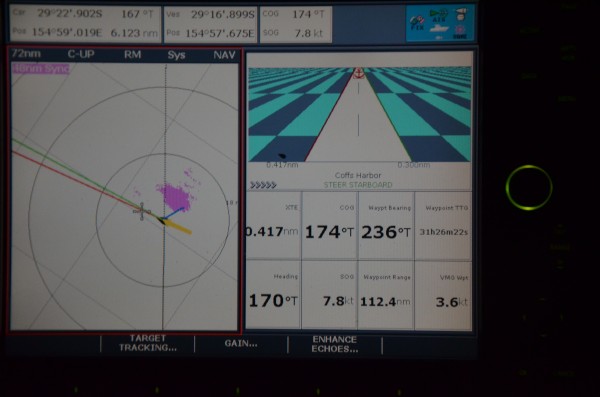
The arrival of daylight around 4:30 AM brought the lightning show to an end. As is typical with storms of this nature, they tend to fall apart as the atmosphere heats up with the arrival of the morning sun. It was as if someone flipped a switch and the electrical fireworks disappeared. Thank God.
That hour or two of concern (let's put a brave face on and not call it terror) did teach us something. The lightning we experienced was actually predicted! Looking at the weather files later, I discovered that the CAPE index was rather high for that afternoon and evening - and was predicted six days in advance. CAPE is a measurement of energy potential in the atmosphere and a high reading can indicate the potential for development of thunderstorms and lightning.
We will never ignore that weather data section again. Ever. Promise.
98% of the time... No. The actual sailing - being on the ocean for several days and nights in a row - is often more tedious than anything and hard to describe as scary.
The most scary part of a making a crossing for us, (if "scary" is the right word - perhaps "the most anxious part" is a better descriptor) comes before departure, before actually being out on the ocean. Other sailors may feel differently, but our anxiousness revolves around trying to predict the weather on the upcoming passage and choosing the right time to leave. In Sailor-ease, this is called choosing a good "weather window".
Choosing a good weather window is a funny thing. On the not-so-funny end of things is the obvious "bad" weather window - leaving during a storm or (maybe worse) sailing into a storm. On the other end of the scale are flat calm seas, which might sound pleasant, but this end of the scale is often accompanied by no wind. Remember, we're a sailboat. Wind propels us. Yes, we do have engines, but they're really not much fun to use. They make noise, the exhaust smells, the fuel they use is costly and using them for an extended period of time can become quite boring. Sailing is much more fun and mentally challenging. To sail, we need wind.
So wind is good. Too much wind is bad and too little wind is bad in it's own rather annoying way. Fretting over choosing a good weather window has something of a Goldilocks process to it - oh that's too much, oh that's too little, oh that's just right.
On top of all that, figuring out the weather is its own peculiar kind of puzzle made more difficult by the fact that it's all about predicting what will happen out there. It's one thing to look out the window and say "oh, the wind is blowing outside". It's a bit more complicated to say "Oh, the wind WILL be blowing five days from now - 700 miles from here - and at this direction and at this speed". We're not just trying to see what the weather is like right now, we have to predict it, for several days out and a long way away.
So we fret. We sit at our computer and look at weather charts. We pick up our iPad and run various weather apps to see how they are modeling the coming weather. Perhaps we pick up the phone and pay a professional weather router to give us their forecasts and departure advice. We talk with other sailors and ask them what they think about the weather, when do they plan to depart - and why.

Choosing when to leave New Caledonia this time was complicated. Complicated enough that we know several boats who have not even left yet (or left for a day but went back) because the weather systems coming up out of the southern ocean have been difficult to predict these past few weeks, with quick changes occurring daily or with solid predictions of poor sailing conditions on the route they wish to sail keeping them at the dock. Boats sailing to New Zealand from New Caledonia have had a particularly difficult time.
We left with two sailing plans and the idea that we would divert to one or the other if weather changed mid-passage from what was predicted upon departure. Sailing to Australia from New Caledonia affords the luxury of multiple routes given that there is a thousand plus miles of Australian coastline at which to aim. Sailing to New Zealand does not have many options. Sailing there means pretty much going to one spot - Opua or perhaps Whangerie or Auckland, but the difference between those choices is at best 150 miles.
One other thing about bad sailing weather is that it's not so bad if you choose to sail into it. And by bad weather, I don't mean 50 knot winds and 6 meter seas. Nobody chooses to sail into that willingly - at least no one we know. Bad weather for us (or perhaps I should say uncomfortable weather that we try to avoid) is 35 to 40 knots and 4 meter seas. Our sweet spot is 15 knots and 1 meter seas, but we can easily sail in 20 to 25 knots and 2 to 3 meter seas - conditions that are quite common in the South Pacific.
Our forecasts said that on day 3 out of New Caledonia, we would see 25 to 30 knot winds and 3+ meter seas for about 24 hours. That's getting close to the high end of our comfort range, but... it's one thing to choose to sail into those conditions and another to have those conditions take you by surprise. Trying to figure out what kind of surprises might be lurking out there is a major cause of pre-departure fretting. See picture above. Again.
Sure enough, the weather front that was predicted for day 3 showed up as forecast during our passage, but no worries mate, we were ready for it and being ready for it makes all the difference in the world. In fact, when the weather front showed up, it was kind of comforting to know that the models were right and dealing us no surprises. Prior to its arrival, we enjoyed 30 hours of downwind spinnaker sailing in 15 to 20 knots of sunshine, following seas and a bright full moon at night. We could not complain.
Our experience with this front is also something of a tribute to modern sailing. Unlike sailing days of old, we are able to download updated weather forecasts while underway every day via radio or satphone - every 6 hours if we want to. Our weather updates during the passage told us that the predicted front was losing its punch. Given that information we moved to plan 2 - sailing directly to the central Australian coast rather than sailing high (aiming for the north coast) and keeping away from the front coming up from the south for as long as possible. As a result, we plunged directly into the front and worked our way through it in about 12 hours, finding that indeed, it was much weakened from what we anticipated upon departure.
We did get one surprise: Lightning. On day 6, a little over 100 miles away from the coast (and our goal) squalls started to pop up. It was 3 AM, the tropical squall witching hour. Big black stuff was starting to block out the moon. Then in the distance the lightning started. Not sure how other sailors feel about it, but give us big seas and high winds but keep the effing lightning away, please. Of all the things we've faced out on the ocean, it's lightning that scares us the most and definitely makes up the majority of that 2% scary.
We made it through the lightning just fine, but not without some moments of panic with direct strikes into the water in front of us. We diverted from our course to avoid the darkest patches that we could see on our radar and also took preventive action, storing all of our portable electronics in the oven - a Faraday cage of sorts - to protect them from EMP in the event of a close strike.

The arrival of daylight around 4:30 AM brought the lightning show to an end. As is typical with storms of this nature, they tend to fall apart as the atmosphere heats up with the arrival of the morning sun. It was as if someone flipped a switch and the electrical fireworks disappeared. Thank God.
That hour or two of concern (let's put a brave face on and not call it terror) did teach us something. The lightning we experienced was actually predicted! Looking at the weather files later, I discovered that the CAPE index was rather high for that afternoon and evening - and was predicted six days in advance. CAPE is a measurement of energy potential in the atmosphere and a high reading can indicate the potential for development of thunderstorms and lightning.
We will never ignore that weather data section again. Ever. Promise.
Ill des Pins
02 November 2014 | Ill des Pins
Jeff/Melody Photos
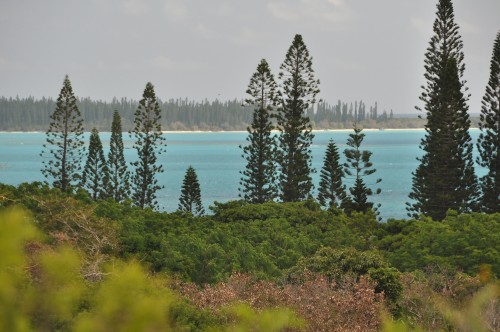
We loved our visit to The Island of Pines, or as it's officially known, Ill des Pins. Or phonetically... Eel day Pa. Or maybe Eel day Pawn with the French pronunciation of the letter "N". English speakers say "N" with the tongue on front roof of the mouth (say NNNNNN...) but French speakers seem to swallow the "N" at the back of the throat, rendering it almost invisible to the English speaking ear and is not a sound made in spoken English - a detail our resident Frenchman onboard Double Diamond, Francois Bonneau, (lovingly referred to by us as Frank Goodwater - which he hates) has been teaching us about French.
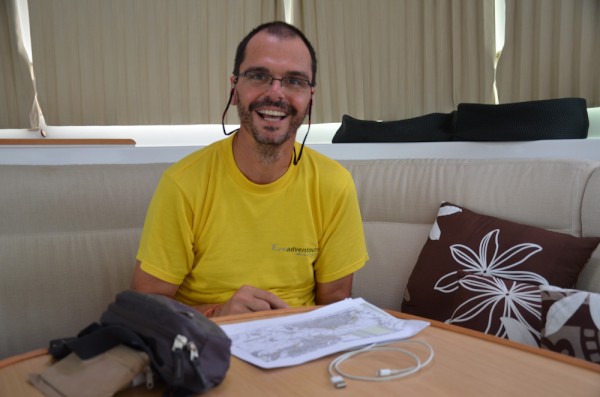
Yet Francois (say France-wah and NOT France-wahs - that's a woman's name) readily admits that his French pronunciation is not classic Parisian. His home is in the southern French city of Toulouse where his last occupation was as an avionics engineer working on Airbus jets. Which, of course, makes him the enemy if you are from Seattle where Boeing puts a lot of meals on local dinner plates. We're well over that, however, and have thoroughly enjoyed having a native French speaker on board even if his Toulouse accent is all messed up, French-wise. Actually, he claims that his recent years of speaking English are messing with his French pronunciation. I believe him.
Although we have known Francois since we were sailing back in Mexico, he was first on board Double Diamond as crew in Fiji and we met up with him again in Noumea (say Newmayuh), New Caledonia. You see, Francois has spent the last two years as a hitchhiker of sorts. Starting out in Mexico, he has pretty much hitchhiked across the Pacific aboard other boats, several of which we know and he is now ending his adventure with us on his final leg, this one to Australia. Except for a short flight from Vanuatu to New Caledonia, he has made the entire crossing as an ocean hitchhiker.
The great thing about Frank, uh, Francois (excuse my French) is that in addition to being a free-spirited people-person, he's also a hard worker and has taken over the task of Chief Dishwasher (which I personally appreciate). He also has no problem with the working end of a stainless steel polishing rag, except for scheduled coffee breaks, which he insists is his right as a French citizen as is his right to go on strike if said coffee breaks are not provided. He's kidding of course, but if you know French culture, you understand the joke.
The engineer in him makes him a fast learner on the technical sailing stuff of which lord knows, there is plenty of technical stuff to learn on board an ocean-equipped sailing vessel. In many ways, he has eclipsed all his instructors in this regard and has certainly shown me a thing or two.
But this story started out about Ill Des Pins, right? (And you are now pronouncing it correctly, right? If not, please refer to paragraph one.)

After getting Francois ensconced on board Double D, we provisioned the boat for the trip to Australia between bouts of French pastry binge eating. (Please refer to the book "Grain Brain" for more details on the ill (not eel) effects of this diet.) Our hope was to provision and then sail about 70 miles out to Ill Des Pins (say it right!), but the complication with that plan is that there are no customs officials on that island and legally speaking, checking out of the country has to be done in Noumea (say Newmayuh, please). Which would mean sailing back to Noumea after visiting Ill Des Pins and then leaving for Australia from there. The problem? Going back to Noumea is not really in the direction of Australia. Kind of, but not really.
Cue our French speaking crewmate.
During the checkout procedures, which involved bicycling around town to several offices (Customs, Immigration, Harbor Master), it was imperative that Francois accompany us as he needed to be added to the official crew-list, exit documents, etc. and have his Passport stamped. While sitting with the Customs official (who spoke only halting English), we asked if it was possible to leave New Caledonia via Ill Des Pins. He said no, not unless we submitted a written request several weeks in advance. To which (I later learned outside the door) Francois said to him (all in French) "Really, it takes that long? These are both pretty nice people whom I've known for quite some time and they've never been here before. Are you sure?" The official looked us over, pulled a form out of a cabinet, signed and stamped it, giving us 72 hours in Ille Des Pins before exiting the country without having to return to Noumea.
Good work, Francois. You just earned a free sailing trip to Australia. Mate.
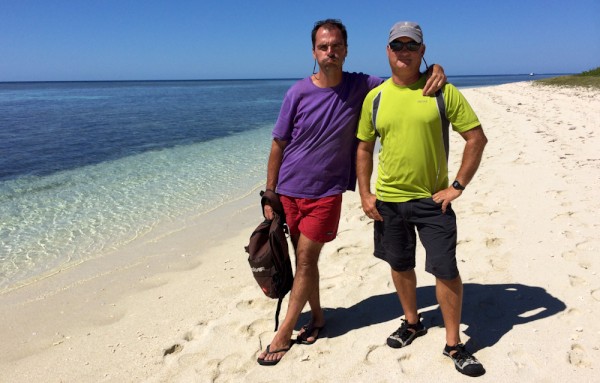
But about Ill Des Pins. It was lovely and Francois, who spent almost a month on the main island of New Caledonia, feels this island was by far the most picturesque. We were able to get our bikes out and do some cycling, but for a complete circumnavigation we rented scooters, draping duffle bags full of snorkel gear across our feet for our day-long, around-the-island road trip.
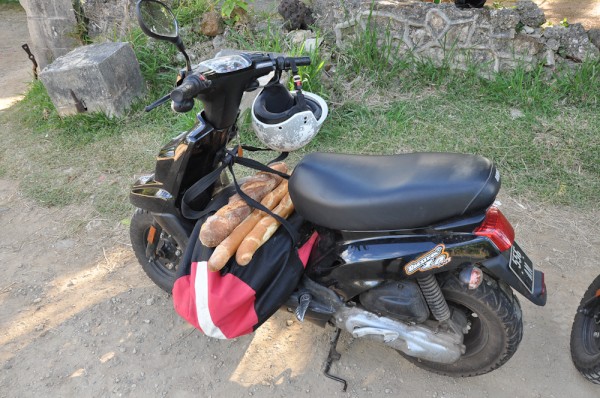
Our goal with the snorkel gear was to swim in what is called la piscine naturelle - the natural pool. Although somewhat mobbed by tourists - even without a cruise ship anchored in the bay - it was still a worthwhile adventure to find and go for a swim in this huge, but calm saltwater pool fed by an incoming stream from the ocean. Luckily, we arrived there before the crowds and had the place to ourselves for a while.
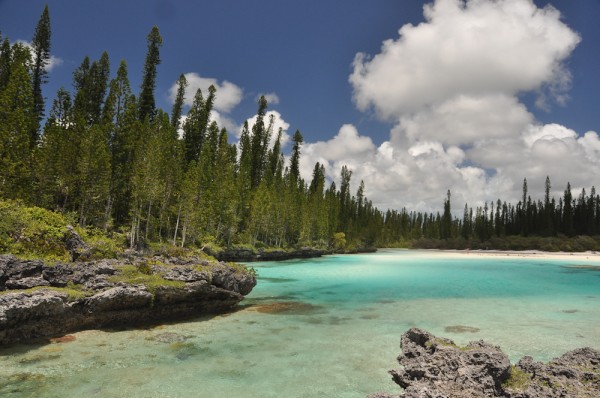
To top the afternoon off, we found a lovely resort, Le Meridian, for lunch after our swim. We could happily stay there for a full week as we've not seen a South Pacific resort with a lovelier and more interesting setting. We did not, however, check on the room rates. My guess is that we might then have to revise our length of stay - downward. Lunch for 3 was $90, but quite elegant - if burgers and sandwiches can be such a thing - which they were.
Other than Le Meridian, the island is very, very rural making us glad we had resupplied in Noumea, but the views were tremendous, the scenery completely different from anything we'd so far seen in the Pacific and the anchorage (Baie Kuto) was large, calm, with good sand holding in 15-25 feet of water and full of turtles and their companion Remoras. We'd go back.
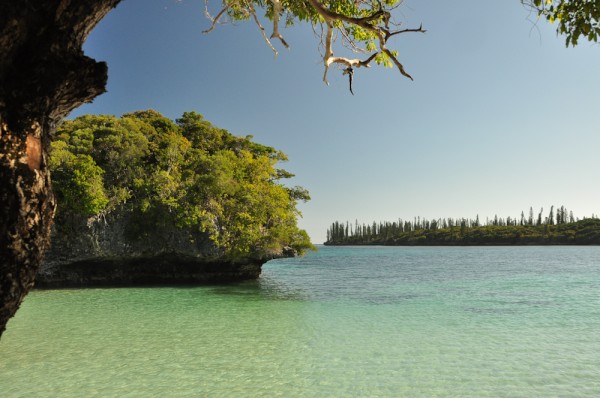

Yet Francois (say France-wah and NOT France-wahs - that's a woman's name) readily admits that his French pronunciation is not classic Parisian. His home is in the southern French city of Toulouse where his last occupation was as an avionics engineer working on Airbus jets. Which, of course, makes him the enemy if you are from Seattle where Boeing puts a lot of meals on local dinner plates. We're well over that, however, and have thoroughly enjoyed having a native French speaker on board even if his Toulouse accent is all messed up, French-wise. Actually, he claims that his recent years of speaking English are messing with his French pronunciation. I believe him.
Although we have known Francois since we were sailing back in Mexico, he was first on board Double Diamond as crew in Fiji and we met up with him again in Noumea (say Newmayuh), New Caledonia. You see, Francois has spent the last two years as a hitchhiker of sorts. Starting out in Mexico, he has pretty much hitchhiked across the Pacific aboard other boats, several of which we know and he is now ending his adventure with us on his final leg, this one to Australia. Except for a short flight from Vanuatu to New Caledonia, he has made the entire crossing as an ocean hitchhiker.
The great thing about Frank, uh, Francois (excuse my French) is that in addition to being a free-spirited people-person, he's also a hard worker and has taken over the task of Chief Dishwasher (which I personally appreciate). He also has no problem with the working end of a stainless steel polishing rag, except for scheduled coffee breaks, which he insists is his right as a French citizen as is his right to go on strike if said coffee breaks are not provided. He's kidding of course, but if you know French culture, you understand the joke.
The engineer in him makes him a fast learner on the technical sailing stuff of which lord knows, there is plenty of technical stuff to learn on board an ocean-equipped sailing vessel. In many ways, he has eclipsed all his instructors in this regard and has certainly shown me a thing or two.
But this story started out about Ill Des Pins, right? (And you are now pronouncing it correctly, right? If not, please refer to paragraph one.)

After getting Francois ensconced on board Double D, we provisioned the boat for the trip to Australia between bouts of French pastry binge eating. (Please refer to the book "Grain Brain" for more details on the ill (not eel) effects of this diet.) Our hope was to provision and then sail about 70 miles out to Ill Des Pins (say it right!), but the complication with that plan is that there are no customs officials on that island and legally speaking, checking out of the country has to be done in Noumea (say Newmayuh, please). Which would mean sailing back to Noumea after visiting Ill Des Pins and then leaving for Australia from there. The problem? Going back to Noumea is not really in the direction of Australia. Kind of, but not really.
Cue our French speaking crewmate.
During the checkout procedures, which involved bicycling around town to several offices (Customs, Immigration, Harbor Master), it was imperative that Francois accompany us as he needed to be added to the official crew-list, exit documents, etc. and have his Passport stamped. While sitting with the Customs official (who spoke only halting English), we asked if it was possible to leave New Caledonia via Ill Des Pins. He said no, not unless we submitted a written request several weeks in advance. To which (I later learned outside the door) Francois said to him (all in French) "Really, it takes that long? These are both pretty nice people whom I've known for quite some time and they've never been here before. Are you sure?" The official looked us over, pulled a form out of a cabinet, signed and stamped it, giving us 72 hours in Ille Des Pins before exiting the country without having to return to Noumea.
Good work, Francois. You just earned a free sailing trip to Australia. Mate.

But about Ill Des Pins. It was lovely and Francois, who spent almost a month on the main island of New Caledonia, feels this island was by far the most picturesque. We were able to get our bikes out and do some cycling, but for a complete circumnavigation we rented scooters, draping duffle bags full of snorkel gear across our feet for our day-long, around-the-island road trip.

Our goal with the snorkel gear was to swim in what is called la piscine naturelle - the natural pool. Although somewhat mobbed by tourists - even without a cruise ship anchored in the bay - it was still a worthwhile adventure to find and go for a swim in this huge, but calm saltwater pool fed by an incoming stream from the ocean. Luckily, we arrived there before the crowds and had the place to ourselves for a while.

To top the afternoon off, we found a lovely resort, Le Meridian, for lunch after our swim. We could happily stay there for a full week as we've not seen a South Pacific resort with a lovelier and more interesting setting. We did not, however, check on the room rates. My guess is that we might then have to revise our length of stay - downward. Lunch for 3 was $90, but quite elegant - if burgers and sandwiches can be such a thing - which they were.
Other than Le Meridian, the island is very, very rural making us glad we had resupplied in Noumea, but the views were tremendous, the scenery completely different from anything we'd so far seen in the Pacific and the anchorage (Baie Kuto) was large, calm, with good sand holding in 15-25 feet of water and full of turtles and their companion Remoras. We'd go back.

J'aime Nouvelle-Caledonie
01 November 2014
Jeff/Melody
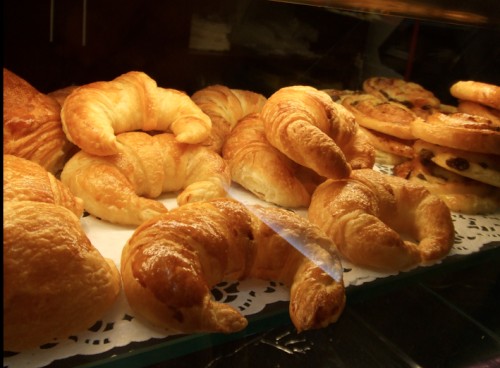
Maybe New Caledonia (or Nouvelle-Caledonie, as they say here) is not so safe after all. They do have one very big problem: Patisseries.
What's a Patisserie? It's the little French bakeries filled with Croissants, Pain du Chocolate, Baguettes and other kinds of sweet baked butter bombs. Everything inside the doors of these establishments is extremely tasty. And very dangerous. It's definitely not Paleo.
The Frenchness (that's a word, right?) of New Caledonia is apparent the moment one steps ashore. Noumea is not Paris, but an urban French outpost plopped down in the middle of the South Pacific filled to the brim with everything French. French cars, French grocery stores and French clothing stores.
Did I mention French pastries? Oh yeah. I did.
There is a French MacDonald's here and yes we had lunch there. We were curious to try the MacBaguette Burger, posters of which are plastered all over the place. Verdict? Not bad - at first. An hour later it earned the moniker McBadgutbomb.
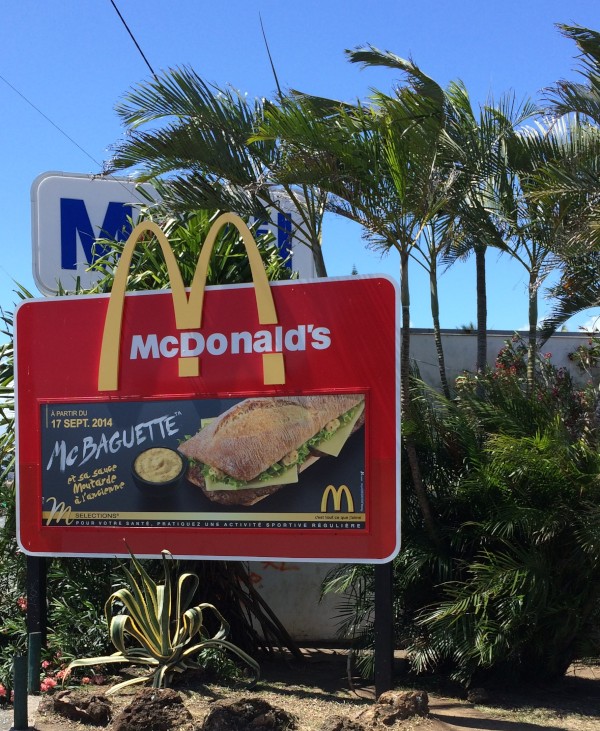
Tahiti is certainly French influenced, but New Caledonia and in particular, the city of Noumea is far more French than French Polynesia. It is also much more wealthy than French Polynesia and that wealth is readily apparent simply walking the streets. Everything is in good repair! The crosswalks all have walk signals (and they work), chiming a tune when it's time to cross the street that we swear is the first few notes of Frere Jacques. Drivers even stop for you when you cross, which is a decided change from the culture of New Zealand, where pedestrians take their life in their hands when stepping off the sidewalk.
Besides heavy financial support from the French government, New Caledonia also produces about 1/3 of the worlds' nickel supply and apparently it all gets shipped directly to France. We happened to see one of New Cal's two big mining operations when we hiked up into the hills above our first anchorage. What we thought was a city (from how it lit up the sky the night before) turned out to be a mine and a gigantic smelting operation.
Have you seen the movie Avatar? As we hiked up the ridge and this operation revealed itself in the valley of the next ridge over, it looked like real-life science fiction plopped down in the middle of wilderness. It was actually pretty impressive as you might expect from a $6 billion dollar investment, but you can also see why the whole operation is rather controversial among New Caledonians. It's making a big mess in the middle of a very scenic nowhere. But walking the streets of Noumea, it's quite clear that it also brings in a great deal of money, money that is not present in a resource-poor place like French Polynesia.
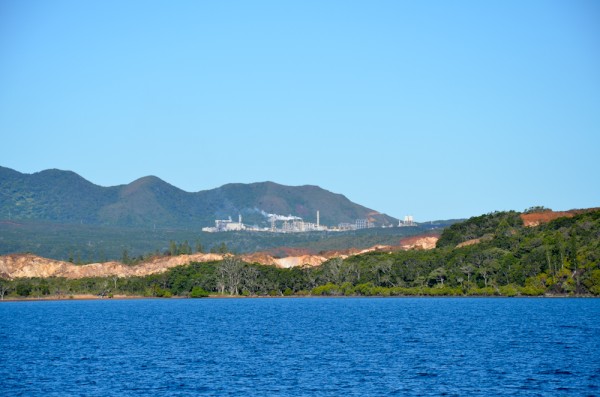
New Caledonia has been influenced by more than its unique geology. It has also been influenced by it unique geography - its position on the planet.
During WWII the island was the last geographical barrier between Japan and Australia/New Zealand and as a result, the island played a pivotal role in the War of the Pacific. During that war over 1 million American servicemen and women passed through New Caledonia either on their way to fight the Japanese or coming back wounded from fighting the Japanese.
This place became a complete United States military camp including a naval base, an airbase, an army base, a hospital base - you name it. Many of the major military campaigns that took place in the pacific had its men and supplies come through New Caledonia. During that time, the US military transformed both the island and the city of Noumea.
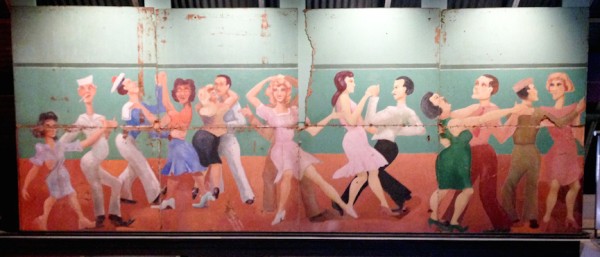
New Caledonia was also one of the few bastions of Free France - those French who refused to participate in the Vichy government installed by Germany after the German invasion of France and wanted to fight Germany rather than be taken over by it. The two-barred cross or the Croix de Lorraine was the symbol of the Free French. A huge version of it, constructed of corten steel, overlooks the city from one of its highest hills.
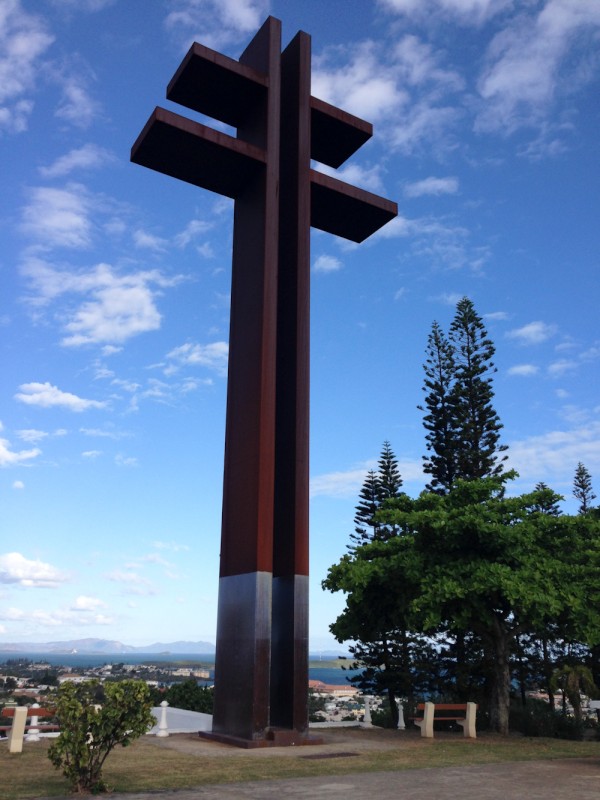
Ultimately, it was not the struggle in Europe that played out here during the war. It was the war in the Pacific, the war against the Japanese that is the central WWII story here even though many New Caledonians did go to Europe and North Africa at the beginning of the war in Europe.
It was WWII that thrust New Caledonia into the modern world and changed it forever - at least that's the claim in the museums we have visited and it's probably more accurate than just sentimental. Certainly the pictures on the walls show a place overrun by US servicemen and the machines of war, not to mention that unique architectural gift of WWII - the Quonset Hut.
Except for the several memorials to that time around the city (one in particular expressing gratefulness to the United States for saving New Caledonia from Japanese invasion) very little physical evidence of the war remains today. Although... there is the issue of the muddy junk on the bottom of certain parts of the bay, which can make anchoring a little problematic for certain catamarans we know - but that's another story.
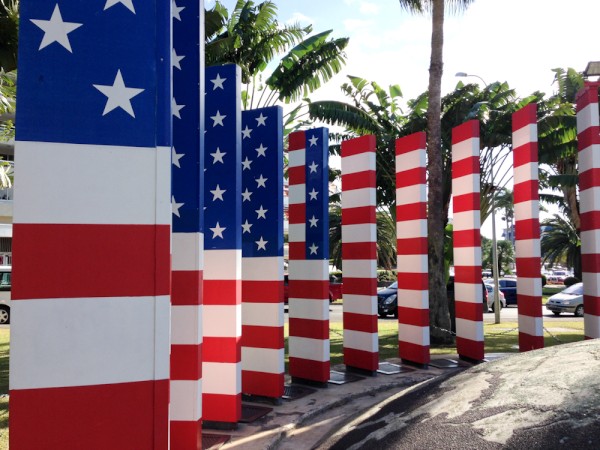
What's a Patisserie? It's the little French bakeries filled with Croissants, Pain du Chocolate, Baguettes and other kinds of sweet baked butter bombs. Everything inside the doors of these establishments is extremely tasty. And very dangerous. It's definitely not Paleo.
The Frenchness (that's a word, right?) of New Caledonia is apparent the moment one steps ashore. Noumea is not Paris, but an urban French outpost plopped down in the middle of the South Pacific filled to the brim with everything French. French cars, French grocery stores and French clothing stores.
Did I mention French pastries? Oh yeah. I did.
There is a French MacDonald's here and yes we had lunch there. We were curious to try the MacBaguette Burger, posters of which are plastered all over the place. Verdict? Not bad - at first. An hour later it earned the moniker McBadgutbomb.

Tahiti is certainly French influenced, but New Caledonia and in particular, the city of Noumea is far more French than French Polynesia. It is also much more wealthy than French Polynesia and that wealth is readily apparent simply walking the streets. Everything is in good repair! The crosswalks all have walk signals (and they work), chiming a tune when it's time to cross the street that we swear is the first few notes of Frere Jacques. Drivers even stop for you when you cross, which is a decided change from the culture of New Zealand, where pedestrians take their life in their hands when stepping off the sidewalk.
Besides heavy financial support from the French government, New Caledonia also produces about 1/3 of the worlds' nickel supply and apparently it all gets shipped directly to France. We happened to see one of New Cal's two big mining operations when we hiked up into the hills above our first anchorage. What we thought was a city (from how it lit up the sky the night before) turned out to be a mine and a gigantic smelting operation.
Have you seen the movie Avatar? As we hiked up the ridge and this operation revealed itself in the valley of the next ridge over, it looked like real-life science fiction plopped down in the middle of wilderness. It was actually pretty impressive as you might expect from a $6 billion dollar investment, but you can also see why the whole operation is rather controversial among New Caledonians. It's making a big mess in the middle of a very scenic nowhere. But walking the streets of Noumea, it's quite clear that it also brings in a great deal of money, money that is not present in a resource-poor place like French Polynesia.

New Caledonia has been influenced by more than its unique geology. It has also been influenced by it unique geography - its position on the planet.
During WWII the island was the last geographical barrier between Japan and Australia/New Zealand and as a result, the island played a pivotal role in the War of the Pacific. During that war over 1 million American servicemen and women passed through New Caledonia either on their way to fight the Japanese or coming back wounded from fighting the Japanese.
This place became a complete United States military camp including a naval base, an airbase, an army base, a hospital base - you name it. Many of the major military campaigns that took place in the pacific had its men and supplies come through New Caledonia. During that time, the US military transformed both the island and the city of Noumea.

New Caledonia was also one of the few bastions of Free France - those French who refused to participate in the Vichy government installed by Germany after the German invasion of France and wanted to fight Germany rather than be taken over by it. The two-barred cross or the Croix de Lorraine was the symbol of the Free French. A huge version of it, constructed of corten steel, overlooks the city from one of its highest hills.

Ultimately, it was not the struggle in Europe that played out here during the war. It was the war in the Pacific, the war against the Japanese that is the central WWII story here even though many New Caledonians did go to Europe and North Africa at the beginning of the war in Europe.
It was WWII that thrust New Caledonia into the modern world and changed it forever - at least that's the claim in the museums we have visited and it's probably more accurate than just sentimental. Certainly the pictures on the walls show a place overrun by US servicemen and the machines of war, not to mention that unique architectural gift of WWII - the Quonset Hut.
Except for the several memorials to that time around the city (one in particular expressing gratefulness to the United States for saving New Caledonia from Japanese invasion) very little physical evidence of the war remains today. Although... there is the issue of the muddy junk on the bottom of certain parts of the bay, which can make anchoring a little problematic for certain catamarans we know - but that's another story.

Arrival: New Caledonia
17 October 2014
Jeff/Photos Melody
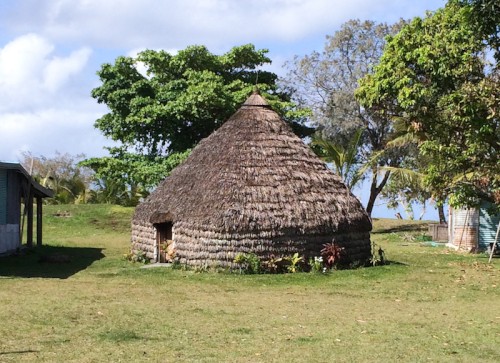
New Caledonia has been a complete change of pace from where we’ve been these past few months. It’s more akin to New Zealand than Vanuatu, yet Vanuatu is only a few hundred miles of ocean away from here. The biggest surprise has been the air temperature. Those few hundred miles separating Vanuatu and Fiji from New Cal are all due south. It’s hard to believe how much of a difference that mileage makes.
At night, it’s almost cold – cold enough to prompt us to dig the fleece out of deep storage and a blanket for the bed – 2 blankets actually. New Caledonia tourist literature claims the weather here is “perpetual spring”. The claim rings rather true.
Let’s be clear: The daytime temperatures are in the mid to high 70’s, nights are mid 60’s. Being from the Seattle area, it’s hard to keep a straight face when describing these temps as cold, but after spending a few months in the tropics it is possible to get used to 80’s and 90’s with 90% humidity and feel chilled by anything less. Regardless, the cooler temps and lower humidity here in New Caledonia are quite nice and something of a relief. The best part is sleeping in a cool cabin under a cozy blanket with a cool, clean breeze coming in through the hatches.
Our sail from Vanuatu was quite fun. Rather than doing it all in one 400+ miles of overnight passages, we broke it up into short hops stopping first on the island of Lifou, which is in the Loyalty Islands and politically part of New Caledonia.
Lifou has a small marina at the community of We’ (pronounced Way). The marina is essentially new and in immaculate condition – but a little empty. We got Double Diamond into an unoccupied slip, assisted by some locals on other boats and once secured, walked into town to check in with the local Gendarmerie, as the customs rules proscribe. We did so, chatting up the very friendly Gendarme present, but he never asked for ID or paperwork – or anything. Actually, he asked for our passports, but we forgot them on the boat and he was OK with it. Same back at the marina – there was no harbormaster to be found. It was pretty clear by the quality of the infrastructure – we walked almost two miles to town on a pristine sidewalk – that we were now back in the first world or something close to it if still somewhat rural. Lifou was super quiet and laid back. So laid back that we never found anyone to take our money for the evening’s moorage fee.
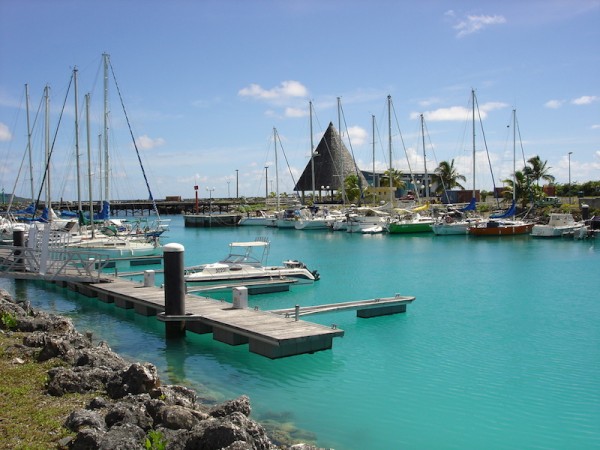
We left the following morning after a nice calm nights sleep in the marina – our first time at a dock in almost 6 months. It was heaven. And as it turned out… free!
We intended to sail to another island in the Loyalties that day, but couldn’t quite sail high enough to get there without a lot of tacking. We were feeling rather lazy after our blissful night at the dock. We decided to go for Havana Passage, an entrance through the reef surrounding the main island of New Caledonia and then anchor for the night at a bay just inside the reef.
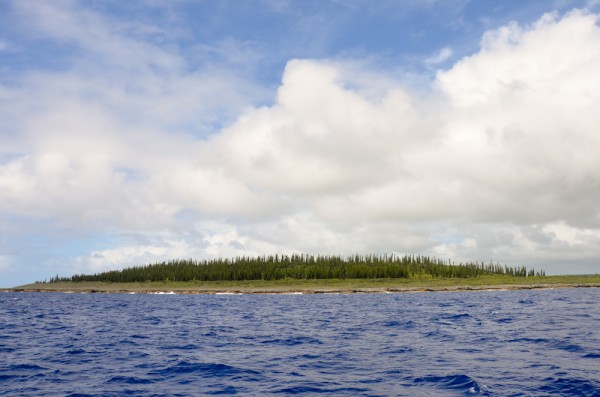
There was one complication with this choice: we would arrive at the entrance to the reef in the dark and then anchor in the dark. But after our experience with the quality of the We’ marina (and it’s well-marked entrance) and the spot-on accuracy of the local charts, we went for it, confident that everything would be as advertised in terms of entrance lights and the like. And it was! The main reef entrance even had a lighted range, giving it the feel of landing at night on an aircraft runway. The bay we chose (Port Boise) was also as advertised on the charts, even with its own lighted reef entrance.
Wow. What a treat to be back in the 1st world. It feels very safe here.
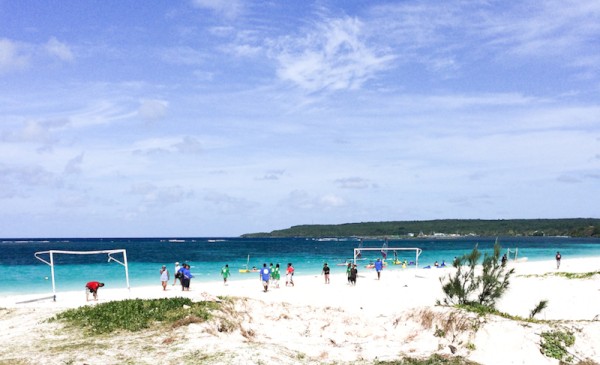
At night, it’s almost cold – cold enough to prompt us to dig the fleece out of deep storage and a blanket for the bed – 2 blankets actually. New Caledonia tourist literature claims the weather here is “perpetual spring”. The claim rings rather true.
Let’s be clear: The daytime temperatures are in the mid to high 70’s, nights are mid 60’s. Being from the Seattle area, it’s hard to keep a straight face when describing these temps as cold, but after spending a few months in the tropics it is possible to get used to 80’s and 90’s with 90% humidity and feel chilled by anything less. Regardless, the cooler temps and lower humidity here in New Caledonia are quite nice and something of a relief. The best part is sleeping in a cool cabin under a cozy blanket with a cool, clean breeze coming in through the hatches.
Our sail from Vanuatu was quite fun. Rather than doing it all in one 400+ miles of overnight passages, we broke it up into short hops stopping first on the island of Lifou, which is in the Loyalty Islands and politically part of New Caledonia.
Lifou has a small marina at the community of We’ (pronounced Way). The marina is essentially new and in immaculate condition – but a little empty. We got Double Diamond into an unoccupied slip, assisted by some locals on other boats and once secured, walked into town to check in with the local Gendarmerie, as the customs rules proscribe. We did so, chatting up the very friendly Gendarme present, but he never asked for ID or paperwork – or anything. Actually, he asked for our passports, but we forgot them on the boat and he was OK with it. Same back at the marina – there was no harbormaster to be found. It was pretty clear by the quality of the infrastructure – we walked almost two miles to town on a pristine sidewalk – that we were now back in the first world or something close to it if still somewhat rural. Lifou was super quiet and laid back. So laid back that we never found anyone to take our money for the evening’s moorage fee.

We left the following morning after a nice calm nights sleep in the marina – our first time at a dock in almost 6 months. It was heaven. And as it turned out… free!
We intended to sail to another island in the Loyalties that day, but couldn’t quite sail high enough to get there without a lot of tacking. We were feeling rather lazy after our blissful night at the dock. We decided to go for Havana Passage, an entrance through the reef surrounding the main island of New Caledonia and then anchor for the night at a bay just inside the reef.

There was one complication with this choice: we would arrive at the entrance to the reef in the dark and then anchor in the dark. But after our experience with the quality of the We’ marina (and it’s well-marked entrance) and the spot-on accuracy of the local charts, we went for it, confident that everything would be as advertised in terms of entrance lights and the like. And it was! The main reef entrance even had a lighted range, giving it the feel of landing at night on an aircraft runway. The bay we chose (Port Boise) was also as advertised on the charts, even with its own lighted reef entrance.
Wow. What a treat to be back in the 1st world. It feels very safe here.

Just Came To Say Hello
14 October 2014 | Port Vila
Jeff
We're sorry to make our visit so short Miss Vanuatu, but New Caledonia is beckoning. Why ditch you so quickly? Perhaps we just came to say hello...
...But maybe an obscure music reference that only our dance crazy granddaughter will recognize won't do. A more detailed explanation of our abrupt departure from the warm embrace of Vanuatu is probably in order.
Reason Number 1: Our boat insurance policy says Double Diamond needs to be south of New Caledonia by November 1st to escape the impending southern hemisphere cyclone season. Most boat policies we're aware of require an exit by December 1st, so a conversation with our broker about this detail is in the air, so to speak and pun intended. Regardless, it's time to head south and heed their (current) advice. Cyclones happen. Why push it?
Reason Number 2: It's WET here. Actually, the rain feels rather good - to a point. It's cooling and has washed (most) all the volcanic ash from Mt. Yasur off the decks, but from what we can see (and hear from other cruisers) the sunny morning/rainy afternoon routine has been pretty much the rule here for the past several months. It's interesting how dry Fiji has been - at roughly the same latitude - and how wet Vanuatu is. No one understands what's up with this. Global Weirding perhaps? Whatever. We're not in the mood for unending afternoon showers. It's not even the rainy season here yet.
Reason Number 3: We love France and most things French (except the cigarette smoking part) and New Caledonia is described as tropical France. Even more French than French Polynesia. We want in and we do not want to be rushed out. Even if our French does suck.
Reason Number 4: Regardless of the afternoon showers thing, the next few days are forecast as an excellent weather window for sailing south to "New Cal" as they call it. 15 knot winds, mild seas, beam reach. Who knows when the next decent weather window will appear? One rule of passage sailing: when the right weather shows up - cast off. Now!
So... we're casting off and bidding adieu to the lovely Miss Vanuatu. The crossing from Port Vila here in Vanuatu to the first port of call in New Cal (the town of We' on the island of Lifou) is just over 200 miles. From there we will sail on to Noumea, the capital city on the main island of New Caledonia.
And then? Australia. But not until we've had our fill of French inhaling.
And Vanuatu? We're sorry. It just wasn't our time.
...But maybe an obscure music reference that only our dance crazy granddaughter will recognize won't do. A more detailed explanation of our abrupt departure from the warm embrace of Vanuatu is probably in order.
Reason Number 1: Our boat insurance policy says Double Diamond needs to be south of New Caledonia by November 1st to escape the impending southern hemisphere cyclone season. Most boat policies we're aware of require an exit by December 1st, so a conversation with our broker about this detail is in the air, so to speak and pun intended. Regardless, it's time to head south and heed their (current) advice. Cyclones happen. Why push it?
Reason Number 2: It's WET here. Actually, the rain feels rather good - to a point. It's cooling and has washed (most) all the volcanic ash from Mt. Yasur off the decks, but from what we can see (and hear from other cruisers) the sunny morning/rainy afternoon routine has been pretty much the rule here for the past several months. It's interesting how dry Fiji has been - at roughly the same latitude - and how wet Vanuatu is. No one understands what's up with this. Global Weirding perhaps? Whatever. We're not in the mood for unending afternoon showers. It's not even the rainy season here yet.
Reason Number 3: We love France and most things French (except the cigarette smoking part) and New Caledonia is described as tropical France. Even more French than French Polynesia. We want in and we do not want to be rushed out. Even if our French does suck.
Reason Number 4: Regardless of the afternoon showers thing, the next few days are forecast as an excellent weather window for sailing south to "New Cal" as they call it. 15 knot winds, mild seas, beam reach. Who knows when the next decent weather window will appear? One rule of passage sailing: when the right weather shows up - cast off. Now!
So... we're casting off and bidding adieu to the lovely Miss Vanuatu. The crossing from Port Vila here in Vanuatu to the first port of call in New Cal (the town of We' on the island of Lifou) is just over 200 miles. From there we will sail on to Noumea, the capital city on the main island of New Caledonia.
And then? Australia. But not until we've had our fill of French inhaling.
And Vanuatu? We're sorry. It just wasn't our time.
| Vessel Name: | Double Diamond |
| Vessel Make/Model: | Lagoon 440 |
| Hailing Port: | Anacortes, Washington, USA |
| Crew: | Jeff & Melody Christensen |
| About: | |
| Social: |
Double Diamond's Photos - Home
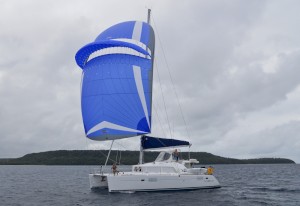
Who: Jeff & Melody Christensen
Port: Anacortes, Washington, USA











